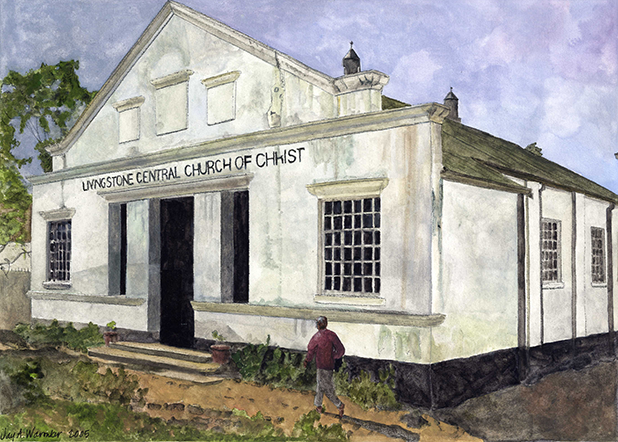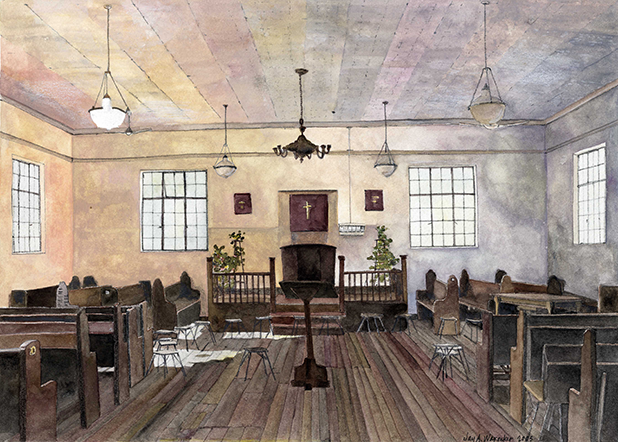 Exterior View (2005), 15” x 11” Watercolor, Jay A. Waronker
Exterior View (2005), 15” x 11” Watercolor, Jay A. Waronker
ZAMBIA
Former Livingstone Hebrew Congregation (Community Dates to 1910) Synagogue (Building Dates to 1928) |
|

Interior View (2005), 15” x 111” Watercolor, Jay A. Waronker
|
Located near the border with Zimbabwe and the world-famous Victoria Falls, Livingstone was for decades home to a flourishing enclave of Jews, many who ran successful local and regional businesses. Life was generally good for Jews in this outpost of the diaspora, where they were free to practice their religion and live productive lives. In fact, the Livingstone Jewish community, dating to 1910, was the first to be organized in Zambia, which was then known as Northern Rhodesia, by mostly German Jews who arrived just before, during, and after World War I.
Early on Jewish prayer services were conducted in Livingstone in private homes or temporary facilities, but within a short time the Jews acquired a plot of land near the center of town for the building of a synagogue. Livingstone’s Jewish community continued to grow slowly in small numbers in the late 1910s and 1920s, further warranting the proper synagogue in town. The property that the Jews had purchased sat empty for some years before the congregation had raised enough enthusiasm and funds to begin the construction project.
The formal ceremony for laying the synagogue’s foundation stone did not happen until 1928, and construction was completed within a few months. It was officially opened by the Chief Secretary of Rhodesia, the Honorable H. A. Northcote, on September 11, 1928 and consecrated by the Reverends M. I. Cohen and A. Weinberg of the Bulawayo Zimbabwe Jewish community. At that time, a Sefer Torah was proudly marched around the new sanctuary space in front of all guests before being placed within the Ark for the first time. Added to the synagogue over time were other small freestanding buildings on the property, including a Jewish school, social hall, and rabbi’s house. These buildings all grouped together formed a Jewish campus in the center of Bulawayo.
The synagogue’s sanctuary building is a modest one-storied structure finished in stucco today painted an off-white color except for a black base. A front parapet wall in a pediment conceals the structure’s roof, which is gabled and covered in galvanized metal sheets. The façade lacks architectural features and decoration except for heavy bands of trim along the base of the building, above the centered opening of the recessed front porch, atop and below the two windows flanking the porch opening, at the area separating the lower mass from the front pediment, along the top edges of the pediment, and at the three panels, today blank, within the pediment. Elsewhere a simple design flourish, also are practical in nature, are the cylindrical metal vents positioned along the sanctuary’s roof ridge.
The interior of the former Livingstone Hebrew Congregation’s sanctuary building features a recessed front porch that leads to the rectangular sanctuary. The sanctuary, measuring 35’ x 50’, for decades ably served the congregation, which seemed to have peaked at just over 100 members in the late 1940s. At the time of this painting, the sanctuary space still contained its original hardwood floors, 2’ square pressed metal painted ceiling tiles, steel casement windows, wood baseboard, wood crown molding and picture railing, and some of the original freestanding wooden benches. Over time, mismatched wooden pews had also been added to space. Some of the sanctuary’s original bronze pendant lighting fixtures were still hanging from the 14’-6” high flat ceiling, although more recent fans had also been added.
Livingstone’s former Hebrew Congregation sanctuary retains its pulpit with Ark, positioned two steps up from the floor level and defined by an original wooden railing. Today the liturgical feature, typically the most prominent one in a synagogue, is unused by its current owner and occupant, the Livingstone Central Church of Christ. This church is affiliated with the American Church of Christ.
The Livingstone Jewish congregation maintained a particularly active religious and social life throughout the 1940s and 50s. Whereas at the time of World War II and in the early 1950s Jewish population had in fact increased marginally in town, a decline in the community seems to have begun in the late 1950s. By the late 1960s, following the freedom movement from British colonial rule and the establishment of an independent Zambia in 1964, Jewish life in Livingstone declined substantially. Jews, like many white Zambians uncertain of their futures in the country, chose to leave at that time. By the 1970s, a Jewish presence in Livingstone had essentially ceased altogether. While there have likely been odd Jews living in Livingstone since that period, at the time this watercolor was painted there seemed to have been none still residing in town.
Since this watercolor was painting, some modest changes have taken place in the sanctuary space, including the laying of a sheet floor over the original yet damaged hardwood, the repainting of the plaster walls, and the hanging of a curtain across the entire wall containing the former ark.
The decline in the Livingstone Jewish population began in the late 1950s, reflecting the relative stagnation of the economics of the town. The nearby Belgian Congo crisis of 1960 may have contributed to some safety concerns among the Jewish population, but a more serious decline began in the years immediately before and after Zambian independence in October 1964. By the late 1960s, the Jewish population of the country fell from around 1,000 to 300. By the close of the 1970s, the Zambian Jewish population was estimated to have fallen below 100 for the first time since before World War I. A decade later, the number had dropped even more, with a minute few living in Livingstone. No longer made up of a congregation large enough to operate and maintain their synagogue, the Jews of Livingstone had no choice but to sell their synagogue campus.
The American Church of Christ, founded in 1987 in Livingstone, bought the former synagogue and its campus of buildings soon after it was organized. At that time the church’s name, the Livingstone Central Church of God, was painted on the synagogue building’s façade. Since then, this black African church that is affiliated with the American Church of Christ has used the buildings for their religious, social, and educational needs. At the time this painting was completed, a computer school was being run out of one of the smaller campus buildings, and others were used for offices and communal activities. The sanctuary building, decently maintained, had changed little since it was built by Livingstone’s Jews. If one looked carefully, even the original Star of David that once adorned the façade could still be faintly made out underneath a thinly-applied layer of paint.
